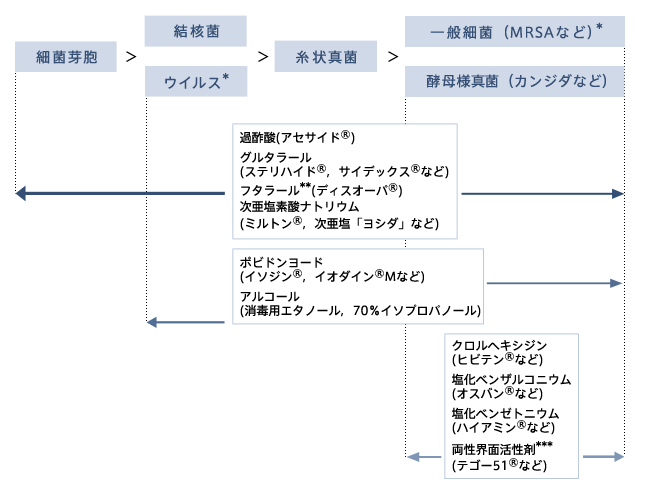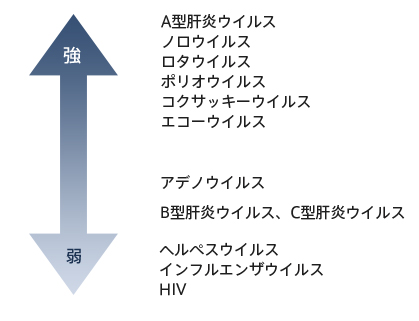消毒薬の選び方
各種微生物に対する消毒薬の選び方
ウイルス
ウイルスは細胞内でのみ増殖可能で、環境では増殖できない。 しかし、ウイルスは環境で比較的長時間生存できる1-4)。 たとえば、乳幼児腸炎の主要な起因菌であるロタウイルスが玩具に付着すると、10日間以上生存する1)。ロタウイルスのほうが大腸菌より乾燥に強いといえる5)。 また、エイズウイルスは環境表面で数日間生存できる2)。 したがって、ウイルスは細菌と同様に、重要な消毒対象である。
1. ウイルスの消毒法
ウイルスに対して有効な消毒薬は、高水準消毒薬(過酢酸、グルタラール、フタラール)および中水準消毒薬(次亜塩素酸ナトリウム、アルコール、ポビドンヨード)である(図1)。 また、ウイルスに対しては80℃・10分間などの熱(熱水や蒸気)も有効である。
ウイルス汚染の器材には、ウォッシャーディスインフェクタやフラッシャーディスインフェクタなどを用いた熱消毒や、高水準および中水準の消毒薬で対応する。 また、ウイルス汚染の環境には、中水準消毒薬のアルコールや次亜塩素酸ナトリウムで対応する。
図1. 微生物の消毒薬抵抗性の強さ、および消毒薬の抗菌スペクトル

* 一部のウイルスの消毒薬抵抗性は、一般細菌と同程度である。
** フタラールの枯草菌の芽胞に対する効果は弱い。
*** 両性界面活性剤は結核菌にも有効である。
2. 各種ウイルスのアルコール抵抗性
アルコールによるウイルスの消毒では、殺滅に要する時間がエンベロープ(外膜)の有無によって異なる6-8)。 すなわち、エンベロープが無いノロウイルスやA型肝炎ウイルスなどでは、エンベロープを有するヘルペスウイルスやインフルエンザウイルスなどに比べて、より長時間のアルコールへの接触が必要になる。 たとえば、ノロウイルスの消毒では30秒間、A型肝炎ウイルスの消毒では1分間の接触が必要である。 図2には、各種ウイルスのアルコール抵抗性の強さについて示した。
図2.ウイルスのアルコール抵抗性の強さ

引用文献
- Sattar SA, Lloyd-Evans N, Springthorpe VS et al: Institutional outbreaks of rota-virus diarrhoea: potential role of fomites and environmental surfaces as vehicles for virus transmission. J Hygine (Camb) 96: 277-289, 1986.
- Valenti WM (ed): AIDS: Problem solving in infection control. Am J Infect Control 17: 39-41, 1989.
- Zachoval R, Frösner G, Deinhardt F, et al: Persistence of hepatitis B virus antigens in dried blood. Lancet 1: 778, 1981.
- Doultree JC, Druce JD, Birch CJ, et al: Inactivation of feline calicivirus, a Norwalk virus surrogate. J Hosp Infect 41: 51-57, 1999.
- Ansari SA, Sattar SA, Springthorpe VS, et al: In vivo protocol for testing efficacy of hand-washing agents against viruses and bacteria: experiments with rotavirus and Escherichia coli. Appl Environ Microbiol 55: 3113-3118, 1989.
- Mbithi JN, Springthorpe VS, Sattar SA: Chemical disinfection of hepatitis A virus on environmental surfaces. Appl Environ Microbiol 56: 3601-3604, 1990.
- for Disease Control and Prevention: Updated norovirus outbreak manage-ment and disease prevention guidelines. MMWR 60 (No.3): 1-14, 2011.
- Croughan WS, Behbehani AM: Comparative study of inactivation of her-pes simplex virus types 1 and 2 by commonly used antiseptic agents. J Clin Microbial 26: 213-215, 1988.







